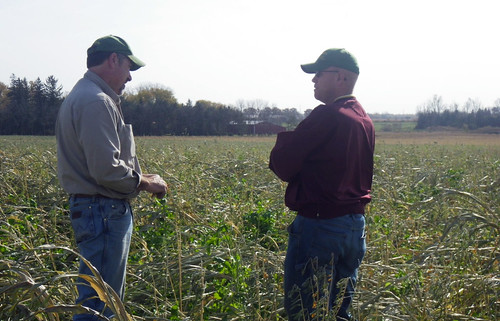
Last spring, USDA’s Natural Resources Conservation Service (NRCS) in Minnesota named five watersheds eligible for funding through the Mississippi River Basin Healthy Watersheds Initiative (MRBI). Dobbins Creek, located in Mower County, was one of the selected watersheds.
About 25,700 acres in size, the Dobbins Creek watershed winds through prime farmland and flows along the northeast edge of the city of Austin. NRCS has committed $488,000 for conservation activities in the watershed over the next 5 years and obligated $51,402 through its Environmental Quality Incentives Program (EQIP) in fiscal year 2015.
NRCS and the Mower Soil and Water Conservation District (SWCD) are working together to provide outreach to agricultural producers and landowners within Dobbins Creek. “I used the Mower County parcel GIS layer and the Dobbin Creek watershed boundary to target producers and landowners, and then I picked up the phone,” said Andrea Horsman, District Conservationist. “The MRBI contracts funded in 2015 were for implementing and adopting cover crops into the existing management system.” Using cover crops is a different type of management for farmers in Andrea’s area.
Dean Thomas, an NRCS Soil Health Technician for the southeast portion of the state, met with farmers interested in cover crops. “Thomas’s expertise and his own experience with soil health are a huge asset to the field offices in Southeast Minnesota,” said Horsman.
Tom Finnegan, a local producer, was interested in preventing soil erosion, building organic matter, reducing tillage on his farm, and incorporating his cow-calf operation with his cropland.
“I read through several articles and watched videos of Gabe Brown, a North Dakota farmer who is known as an early adopter of soil health practices and I really believe what Brown was doing is right.”
During the month of August, Finnegan no-till drilled in a 6-species cover crop mix on 32.5 acres and no-till drilled in a 3-species mix following a pea crop that will be used for his cow-calf operation to graze in the fall. In September, he also no-tilled 35 acres following sweet corn with a 2-species cover crop mix and he aerial seeded 84.5 acres of cover crops on corn with a 3-species cover crop mix, all with MRBI support.
“His land was an ideal fit for MRBI technical and financial assistance,” said Thomas. “A perfect way for him to accomplish his goals was to implement multiple species of cover crops that feed the soil and his cow-calf operation,” Thomas said.
Conservation planning and program implementation is a true locally-led partnership.
The conservation staff in Mower County are passionate about working with farmers to plan and apply conservation techniques on the land. Through MRBI, agricultural producers strive to improve water quality, restore wetlands, and enhance wildlife habitat in small watersheds in the Mississippi River Basin states of Arkansas, Kentucky, Illinois, Indiana, Iowa, Louisiana, Minnesota, Mississippi, Missouri, Ohio, Tennessee, South Dakota and Wisconsin.
Since MRBI started in 2009, NRCS has worked with more than 600 partners and 5,000 farmers to improve more than 1 million acres in the region. Through these partnerships, the initiative has more than quadrupled the number of contracts addressing water quality concerns in targeted project areas. NRCS will invest $30 million per year for such projects through 2018 as part of a $100 million, four-year investment from the 2014 Farm Bill.



